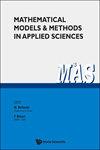进入:物理学的新前沿
IF 3
1区 数学
Q1 MATHEMATICS, APPLIED
Mathematical Models & Methods in Applied Sciences
Pub Date : 2023-01-01
DOI:10.12988/ams.2023.917451
引用次数: 0
摘要
黑洞(BH)的形成通过极端恒星(ES,平均密度相当于或大于中子平均密度)不稳定性,由于质量增加,被认为是从普通(能量+物质)到不可分割的理想流体(ENTER)的相变。利用对应态原理,将bh和ESs与具有等质量、赤道半径和转动惯量的经典非均质圆盘关联起来[5],其中表面密度分布服从幂律。对于静态(TOV)和赤道破碎(EQB)构型,ES约简(无量纲)参数被推断[19]并从早期的结果中修正[5],并与以下BH关系进行比较:(减少的转动惯量)-(减少的角动量);(旋转度,/ Ω = β Ω R/c)-(角动量减小);(角动量)-对数列构型在对数平面上的质量,其中简化后的角动量保持不变。先前对大量状态方程(EOSs)[3][23]和常数约化角动量序列[3]的研究推断出ES(约化惯性矩)-紧性关系,并将其外推到不稳定区域38 < β < 12,结果与相关的黑洞对应项β = 12一致。与黑洞类似,通过相应状态原理相关联的经典非均质盘的表面密度分布随着径向距离的增加而增加,这与指定EOS的TOV和EQB构型相反,这使得可以制定ES稳定性的经验准则。本文章由计算机程序翻译,如有差异,请以英文原文为准。
ENTER: a new frontier in physics
Black hole (BH) formation via extreme star (ES, mean density comparable to or larger than neutron mean density) instability, due to increasing mass, is conceived as a phase transition from ordinary (energy + matter) to ENTER, an indivisible ideal fluid. BHs and ESs are re-lated to classical, heterogeneous disks of equal mass, equatorial radius, moment of inertia, where surface density distribution obeys a power law, by use of a principle of corresponding states [5]. With regard to static (TOV) and equatorial breackup (EQB) configurations, ES reduced (di-mensionless) parameters are inferred [19] and revised [5] from earlier results, and compared to the following BH relations: (reduced moment of inertia)-(reduced angular momentum); (swivelness, / Ω = β Ω R/c )- (reduced angular momentum); (angular momentum)-mass in logarithmic plane for sequences of configurations where reduced angular momentum remains unchanged. ES (reduced moment of inertia)-compactness relation, inferred in earlier investigations for a large number of equations of state (EOSs) [3][23] and sequences of constant reduced angular momentum [3], is extrapolated across the instability region, 38 < β < 12 , and results are consistent with related BH counterparts, β = 12 . Similarly to BHs, classical heterogeneous disks associated via a principle of corresponding states exhibit surface density distribution increasing with radial distance, contrary to TOV and EQB configurations with assigned EOS, which allows the formulation of an empirical criterion for ES stability.
求助全文
通过发布文献求助,成功后即可免费获取论文全文。
去求助
来源期刊
CiteScore
6.30
自引率
17.10%
发文量
61
审稿时长
1 months
期刊介绍:
The purpose of this journal is to provide a medium of exchange for scientists engaged in applied sciences (physics, mathematical physics, natural, and technological sciences) where there exists a non-trivial interplay between mathematics, mathematical modelling of real systems and mathematical and computer methods oriented towards the qualitative and quantitative analysis of real physical systems.
The principal areas of interest of this journal are the following:
1.Mathematical modelling of systems in applied sciences;
2.Mathematical methods for the qualitative and quantitative analysis of models of mathematical physics and technological sciences;
3.Numerical and computer treatment of mathematical models or real systems.
Special attention will be paid to the analysis of nonlinearities and stochastic aspects.
Within the above limitation, scientists in all fields which employ mathematics are encouraged to submit research and review papers to the journal. Both theoretical and applied papers will be considered for publication. High quality, novelty of the content and potential for the applications to modern problems in applied sciences and technology will be the guidelines for the selection of papers to be published in the journal. This journal publishes only articles with original and innovative contents.
Book reviews, announcements and tutorial articles will be featured occasionally.

 求助内容:
求助内容: 应助结果提醒方式:
应助结果提醒方式:


